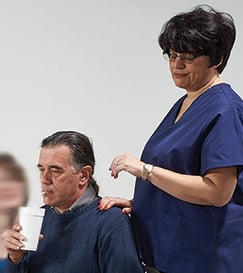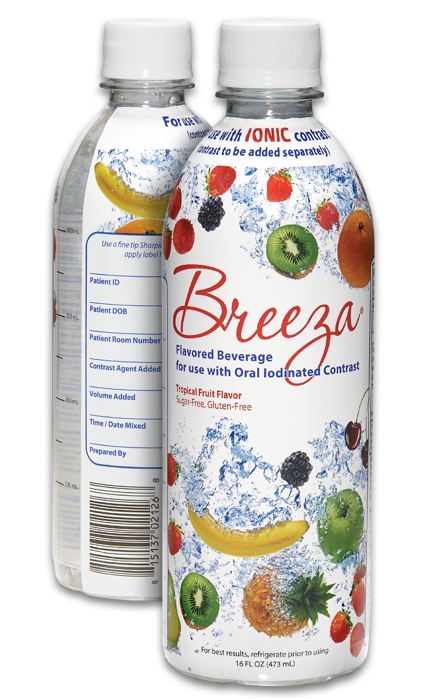
Patients who have had an abdominal CT scan say that drinking the contrast before the procedure can be the worst part of the whole process because of the texture and/or flavor.
However, this is a very important step in getting the best images possible for interpretation and diagnosis. The oral contrast is used in order to make specific organs “stand out” and better show the presence of disease or injury.
The different types of oral contrast for CT
There are a variety of oral contrasts that are used during a CT scan. Each is used depending on the patient that is being imaged and their specific situation.
The most commonly used contrast is a barium-sulfate solution. It can come in a variety of flavors and is usually mixed with water. The biggest challenge patients have with drinking this contrast solution is the texture, which is thick and chalky.
Barium-sulfate (Readi-Cat) is used in most situations except for when the possibility of heading to the operating room is high, a patient is suspected of having a perforated bowel, or is allergic to barium.
Iodinated contrasts (Gastrografin, Gastroview) are not as thick as Barium, but the taste is extremely bitter due to the iodine.
To help make this type of contrast medium more palatable for patients, imaging facilities often add a powdered drink mix like Crystal Light, or some other type of juice or flavoring agent, but the bitterness is hard to mask and many patients still have trouble with drinking the full amount of liquid prescribed for their scan.
Why it’s important to drink all the oral contrast within a specified time
As stated earlier, the purpose of the oral contrast is to opacify the bowels so that the radiologists reviewing the images can see as much as possible and give the correct diagnosis.
 For patients to be fully opacified they must drink all the contrast within a certain time frame, typically between 1-2 hours.
For patients to be fully opacified they must drink all the contrast within a certain time frame, typically between 1-2 hours.
Timing is very important here. Patients need to be scanned at the correct time so that the contrast has a chance to travel or transit through the GI tract.
In a perfect world, a patient who follows the drinking protocol exactly as prescribed, would drink the entire contrast in the correct time frame and would then be scanned once the contrast reaches the rectum.
When a patient can’t drink all the oral contrast due to the taste or texture or drink it in the recommended time frame imaging staff may try to coax/coach the patient to finish drinking. However, prolonged drinking times may disrupt the schedule as well as result in images that are suboptimal.
In the instance of suboptimal images, the radiologist may try to make the best interpretation they can based on the available information, or the patient will need to come back for another scan and go through the whole process again.
Another option for patients who cannot complete their drinking protocol is an Naso-Gastric (NG) tube - which is a thin tube inserted through the nose and threaded into the stomach. The contrast would then be administered through the NG tube. Not only does this also take time, it can also be very uncomfortable for the patient.
According to a recent blind survey of imaging facilities, 80% of facilities will go ahead and scan depending on how much the patient was able to drink, knowing that they may have to reschedule based upon the image quality.
This is less than ideal for everyone involve, especially for the patient who possibly will need to repeat the whole process for the exam and be exposed to additional radiation, or worse, risk a missed diagnosis and delay of treatment due to the suboptimal images.
A radiologist invented solution to make oral contrast easier for patients to drink
Dr. Peter Quagliano is a diagnostic radiologist with a deep interest in the field of oral contrast administration.
He has conducted multiple studies related to the best ways to make oral contrast easier for patients to drink with the ideal window of time for a fully opacified bowel.
In one of his taste test surveys, participants were asked to rate each oral contrast product on a scale of 0 to 10, 0 being “dislike a lot” and 10 being “like a lot”. The results of this survey show just how unpalatable oral contrasts can be, with only one product rating above an 8 (Gastrografin mixed with Kool-Aid), and everything else rating below a 6.
 In his quest to find a better solution for patients, Dr. Quagliano invented and patented a flavored beverage that masks the taste of iodinated oral contrasts by including a bitterness blocker, making it easier for more patients to drink the full amount of oral contrast required for their abdominal scan.
In his quest to find a better solution for patients, Dr. Quagliano invented and patented a flavored beverage that masks the taste of iodinated oral contrasts by including a bitterness blocker, making it easier for more patients to drink the full amount of oral contrast required for their abdominal scan.
Breeza® flavored beverage for use with oral iodinated contrast is the result of all his research and testing.
Breeza’s tropical fruit flavor has been proven to help patients complete their drinking protocols within the desired time frame, Not only does this help with increasing patient satisfaction, it also helps imaging facilities acquire better initial scans.

Megan Sargalski
Marketing Communications Specialist


